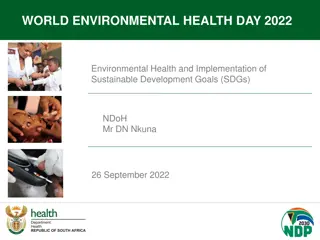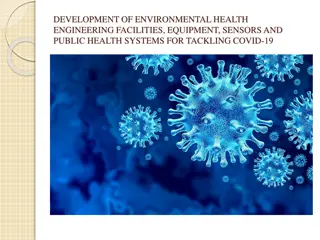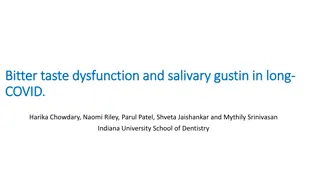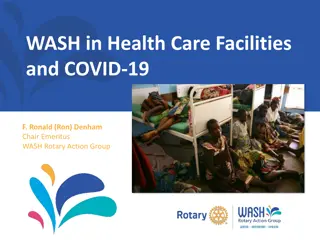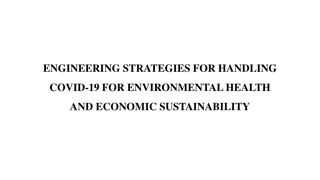
Development of Environmental Health Engineering Facilities for Tackling COVID-19 Pandemic
Coronavirus disease, known as COVID-19, has created a global crisis, emphasizing the need for innovative environmental health engineering solutions to combat the spread of the virus. This term paper discusses the development of facilities, equipment, sensors, and public health systems in response to the pandemic, highlighting the crucial role of engineering in safeguarding public health.
Download Presentation

Please find below an Image/Link to download the presentation.
The content on the website is provided AS IS for your information and personal use only. It may not be sold, licensed, or shared on other websites without obtaining consent from the author. If you encounter any issues during the download, it is possible that the publisher has removed the file from their server.
You are allowed to download the files provided on this website for personal or commercial use, subject to the condition that they are used lawfully. All files are the property of their respective owners.
The content on the website is provided AS IS for your information and personal use only. It may not be sold, licensed, or shared on other websites without obtaining consent from the author.
E N D
Presentation Transcript
D E V E L O P M E N T O F E N V I R O N M E N TA L H E A LT H E N G I N E E R I N G FA C I L I T I E S , E Q U I P M E N T, S E N S O R S A N D P U B L I C H E A LT H S Y S T E M S F O R TA C K L I N G C O V I D - 1 9 PA N D E M I C PREPARED BY AGWANIRU ROSEMARY 17/ENG01/003
ABSTRACT Coronavirus disease known as COVID-19 is an infectious disease caused by a new virus. The disease causes respiratory illness (like the flu) with symptoms such as a cough, fever, and in more severe cases, difficulty breathing. The spread of the virus has become a pandemic, having 961,749 active cases and 48,165 death cases all over the world. To tackle the spread of the virus firstly the development of environmental health engineering facilities, equipment, sensors and public health systems would be considered and this will be discussed in this term paper.
INTRODUCTION The Coronavirus disease (COVID-19) pandemic (caused by the virus SARS-CoV-2) has increased demand for medicines, vaccines, diagnostics and reagents, all related to COVID-19, creating an opportunity for the chemical engineers and all other fields in engineering to create avenue for the development of environmental health engineering facilities, sensors and public health system to aid in providing this.
During this worldwide crisis, the chemical process industries (CPI) continue to operate to provide products and services that are part of our critical infrastructure. Goggles, face shield, and gowns, as well as items for specific procedures-filtering face piece respirators (i.eN95 or FFP2 or FFP3 standard or equivalent)-hereafter referred to as respirators"-and aprons. Public health has always been, and remains, an interdisciplinary field, and engineering was closely aligned with public health for many years. Indeed, the branch of engineering that has been known at various times as sanitary engineering, public health engineering, or environmental engineering was integral to the emergence of public health as a distinct discipline. The provision of safe water, sanitation and hygienic conditions is essential to protecting human health during all infectious disease outbreaks, including the COVID-19 outbreak. Ensuring good and consistently applied WASH and waste management practices in communities, homes, schools, marketplaces and health care facilities will further help to prevent human-to-human transmission of the COVID-19 virus.
Engineering is obviously found in other content areas and occupations within public health beyond environmental applications. For example, biomedical engineering is prominent within the Food and Drug Administration (FDA), as is safety engineering and industrial hygiene in the National Institute of Occupational Safety and Health (NIOSH) [3]. In this paper, however, we specifically focus on the aspects of engineering that were most closely aligned with the emergence of public health, and that have been known at various times as sanitary engineering, public health engineering, and environmental engineering. We believe that there is a current need to strengthen the connection between this type of engineering and the practice of public health, and an appropriate moniker for this profession is public health engineering
WHAT IS CORONA VIRUS (COVID WHAT IS CORONA VIRUS (COVID- -19)? 19)? Coronavirus disease (COVID-19) is an infectious disease caused by a newly discovered coronavirus. Most people infected with the COVID-19 virus will experience mild to moderate respiratory illness and recover without requiring special treatment. Older people, and those with underlying medical problems like cardiovascular disease, diabetes, chronic respiratory disease, and cancer are more likely to develop serious illness.
WHAT IS ENVIRONMENTAL HEALTH? WHAT IS ENVIRONMENTAL HEALTH? Environmental health is the branch of public health concerned with all aspects of the natural and built environment affecting human health. Environmental health is focused on the natural and built environments for the benefit of human health. The major subdisciplines of environmental health are: environmental science; environmental and occupational medicine, toxicology and epidemiology. As of 2016 the WHO website on environmental health states "Environmental health addresses all the physical, chemical, and biological factors external to a person, and all the related factors impacting behaviours. It encompasses the assessment and control of those environmental factors that can potentially affect health. It is targeted towards preventing disease and creating health-supportive environments. This definition excludes behaviour not related to environment, as well as behaviour related to the social and cultural environment, as well as genetics.
WHAT IS PUBLIC HEALTH? WHAT IS PUBLIC HEALTH? Public health is the science of protecting and improving the health of people and their communities. This work is achieved by promoting healthy lifestyles, researching disease and injury prevention, and detecting, preventing and responding to infectious diseases. Overall, public health is concerned with protecting the health of entire populations. These populations can be as small as a local neighborhood, or as big as an entire country or region of the world. Public health professionals try to prevent problems from happening or recurring through implementing educational programs, recommending policies, administering services and conducting research in contrast to clinical professionals like doctors and nurses, who focus primarily on treating individuals after they become sick or injured. Public health also works to limit health disparities. A large part of public health is promoting healthcare equity, quality and accessibility.
RELATIONSHIP BETWEEN PUBLIC HEALTH AND ENVIRONMENTAL RELATIONSHIP BETWEEN PUBLIC HEALTH AND ENVIRONMENTAL HEALTH HEALTH
CHALLENGES FACED BY PUBLIC AND ENVIRONMENTAL HEALTH DURING COVID-19 PANDEMIC Poor water safety Lack of adequate equipment for treatment and test Air purification challenges Proper sanitization of infected areas.
SOLUTION TO CHALLENGES POOR WATER SAFETY: A water-treatment plant consist of various kinds of unit operations (e.g., separation, transport phenomena, filtration) that only a chemical engineer have studied during a bachelor of chemical engineering program. That is the reason why a chemical engineer is needed to design, operate, control, and maintain a water-treatment facility. Part of the job might be performed by a civil engineer, but under supervision of chemical engineer. Wastewater treatment plant operations should ensure workers follow routine practices to prevent exposure to wastewater. These include using engineering and administrative controls, safe work practices, and PPE normally required for work tasks when handling untreated wastewater. No additional COVID-19 specific protections are recommended for employees involved in wastewater management operations, including those at wastewater treatment facilities.
LACK OF EQUIPMENT FOR TREATMENT AND TEST The first step in tackling an outbreak like this is the protection of frontline staff. Without them, we couldn t respond to the pandemic. Thousands of them are falling ill across affected countries, so keeping them safe and free from infection is key. The next step is realising that, although hospitals are vital to the response, home care and outreach are also really important. In an outbreak, you cannot focus only on hospital care; general practitioners and family doctors have a vital role to play as well. You have to take the wider community into account. As well as the these practioners are needed the facilities for treatment are also needed. Chemical engineering would come alongside other fields of engineering to play a role in ensuring that public health facilities, sensors required at this period of pandemic are provided.
AIR PURIFICATION While air-filtration and dust-collection systems are nothing new for chemical processors, problems arise when existing equipment can no longer keep up with current standards or processes. There are two issues we often see. First, a lot of facilities have legacy systems that aren t properly protected according to current NFPA standards, which is a problem in the chemical industry because they often handle more exotic dusts with higher explosivity ratings, says Steve McConnell, global director of filtration with Schenck Process .
Experts agree that having this type of engineering study is necessary to find the system that will work most efficiently and meet the specific dust collection needs of each facility. And, the two most- asked questions during these studies are how to handle combustible dusts and how to lower the overall cost of the system while providing the most efficient filtration.
PROPER SANITIZATION OF INFECTED AREA: The provision of safe water, sanitation and hygienic conditions is essential to protecting human health during all infectious disease outbreaks, including the COVID-19 outbreak. Ensuring good and consistently applied WASH and waste management practices in communities, homes, schools, marketplaces and health care facilities will further help to prevent human-to-human transmission of the COVID-19 virus.
With the knowledge about chemical compounds and their characteristics chemical engineers can produce sanitizers which would be able to stop the spread of the covid-19 in the environment taking the following compounds below from the knowledge about chemical compounds how sanitizers are produced is described. Two families of acceptable viral disinfectants are quaternary alkyl ammonium compounds ( quats ), and halogen-based disinfectants (namely chlorine bleach and iodofors). The quats are the same compounds found in commercial wet-wipes and various surface disinfection sprays. Quats are effective bacterial and viral disinfectants, and have a strong detergent characteristic. This means they not only neutralize viral or bacterial potency, but also help wash the surfaces clean. Some quat products are combined with water, alcohol, or hydrogen peroxide, but the basic sanitizing aspects are due to the quats. Check the manufacturer s safety data sheet (SDS) for advice on proper dilution and use.
CONCLUSION CONCLUSION Coronavirus disease known as COVID-19 is an infectious disease caused by a new virus. The disease causes respiratory illness (like the flu) with symptoms such as a cough, fever, and in more severe cases, difficulty breathing. The provision of safe water, sanitation and hygienic conditions is essential to protecting human health during all infectious disease outbreaks, including the COVID-19 outbreak. Ensuring good and consistently applied WASH and waste management practices in communities, homes, schools, marketplaces and health care facilities will further help to prevent human-to-human transmission of the COVID-19 virus. The role which a chemical engineer is to play during this times cannot be overemphasizes but together with the various fields of engineering the effect Covid-19 on public and environmental health can be tackled.




